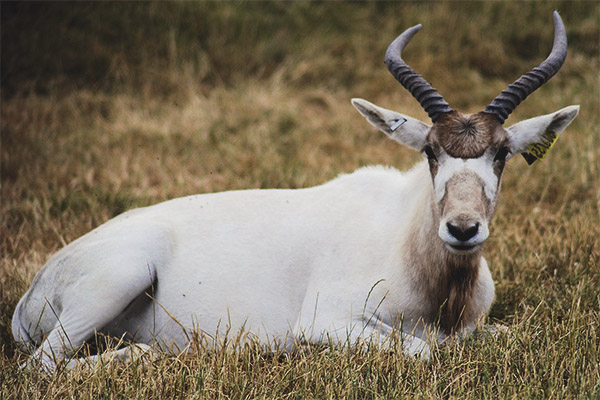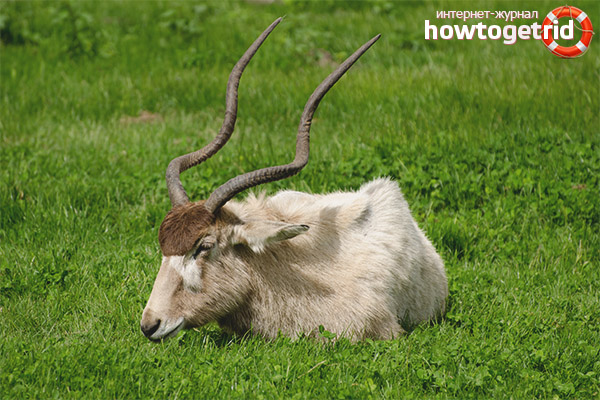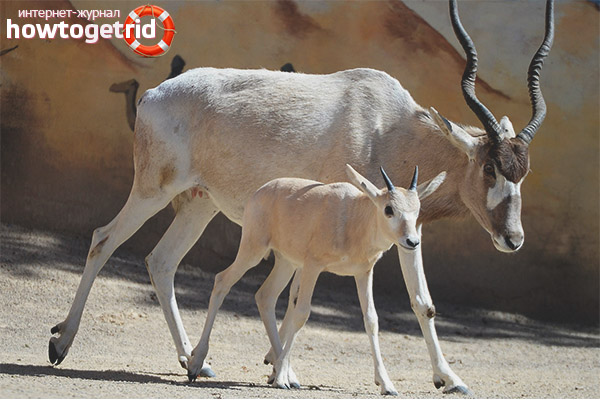The content of the article
By addax is meant an antelope, which is distinguished by unusual external data. For the most part, individuals of the species under discussion are common in Nigeria, Libya, Mali, and Sudan. They like sandy soil and rocky terrain. When family members go in search of food, they can walk a fair distance. It is commonly believed that this hoofed mammal follows rainstorms. We will not run ahead, we will study the features in the next order.
Description
- Pigmentation of the coat is modified depending on what period of the year in question. Species of the presented species can be practically whitish, beige, brown and gray. It is assumed that in the cold season they darken, and in the warm brighten. On the head are the marks of the whitish tone. They are available on the side of the body, hips, abdominal part.On the frontal section there is a patch of dark pigmentation.
- All individuals, regardless of gender, have horns. They are directed to the back, in their structure they have about 2-4 coils. The length is about 0.6 m., But sometimes more. Hooves widescreen. They are set apart because the animals were forced to adapt to movement in deserts and embankments.
- According to the body, the representatives of the genus are drawn up to 1.5 meters; at the withers they grow to one meter. The tail is additionally allotted about 30 cm. Sexual dimorphism is expressed only in the fact that the males are slightly larger than the female representatives of the family. As for the area of residence, these animals do not need fresh water. They can surround themselves with rocks and sand.
- The area does not affect all parts of the globe. To a large extent, the population is dispersed in desert areas. It's about proximity to the Sahara. Meet the discussed representatives of the family in Egypt, Sudan, Libya, Mali, Chad, Mauritania. They like the desert or semi-desert area.
Behavior
- These individuals are characterized by wakefulness at twilight time, as well as before dawn. These time intervals indicate that animals like to be active in the cool. It is this temperature that is observed near the desert when the sun has not come out yet or has already set.
- It is rare to meet members of the species moving alone in the locality. Mostly antelopes are collected in herds of 15 individuals on average. They have a leader who leads his players on the right path. In this way, the endurance of animals is checked, because with the movements the weakest and the sick die.
- When it is necessary to stop for rest, to hide from strong wind or flying sand, animals dig holes in the sand. They fall into the fossa and wait for the moment when it will be possible to continue the journey. Some adventurous addaks hide behind bushes or rocky areas, it all depends on the location of their stay. Animals run slowly, so they can become prey to large predators.
- It can be said with great certainty that members of the family are adapted to the heat. But they also need a shadow to replenish their strength.Individuals have the ability to raise their body temperature to reduce the amount of fluid leaving the body and prevent dehydration. This does not possess other mammals.
- Individuals of the male gender choose for themselves individual plots that can attend females wishing to have offspring. Every male ardently protects their possessions. If suddenly someone enters the territory and tries to lead the female away, a serious bloody fight will begin. In the process of mating for one male representative there is a pair of females.
The enemies
- Since members of the family are considered to be large and move slowly, they are considered excellent prey for humans. People - the main threat, leading to a reduction in the number of heads. Poachers kill individuals for skin and meat.
- Today, these animals are among the rarest. In the natural environment of distribution there are no more than 250 individuals. They live in their element. It is difficult to protect members of the group, as they bypass people and settle far. About a thousand more live in captivity.
Nutrition
- The diet of the animals consists mainly of low shrubs and various herbs. It is noteworthy that individuals are able to overcome impressive distances in the desert. The animal does this in order to find at least some vegetation on such expanses.
- Interestingly, it is precisely the addax among the other relatives that is most adapted to life in such harsh conditions. The desert is not the place where any animal can survive. Individuals manage most of their lives without water. All fluid reserves addaksy get it from plants. Only in this way can the animal survive.
Breeding
- Curiously, the presented animals can reproduce offspring all year round. These individuals do not have a clear mating period. They mate all year round. Often the peak of young stock falls at the end of winter or early spring.
- The female continues to carry babies for 8 months. Then only 1 baby can be born. In extremely rare cases, addaks are born twins. Literally an hour after the birth, babies are already able to run after their mother.
- Interestingly, only the female takes care of the offspring. Juveniles live with their mother throughout the year. After this time, they begin to get used to independent living and leave the family.
- Males reach sexual maturity at the age of about 2 years. Females become sexually mature closer to 3 years. In general, the life span of wild antelope is about 20 years.
Data
- Addax got its name from the Latin word, which literally translates as a wild animal with rounded horns. Also the specific name is characterized as a stained nose. This is due to the fact that the animal has contrasting white spots. They stand out clearly against a dark background in which the head is painted.
- As mentioned earlier, the individuals in question feel wonderful in the desert. Therefore, addaksy literally merge with the situation in the Sahara. Even in summer, such animals have a light color. At the same time they can be observed yellowish or gray. In winter, the color of individuals is a little dark. It helps to blend in with the setting.
- Due to the widely spaced hooves, antelopes represented are able to move along the sand without problems.If a sandstorm rises or the sun unbearably fries, the animals dig deep holes in the sand with their powerful hooves. In such a place, individuals can hide from adverse weather.
It is noteworthy that animals are able to independently raise the temperature of their own body. The bottom line is that when body temperature is equivalent to the environment, the individual sweats less. Accordingly, the animal practically does not lose precious moisture.
Video: addax (Addax nasomaculatus)













To send